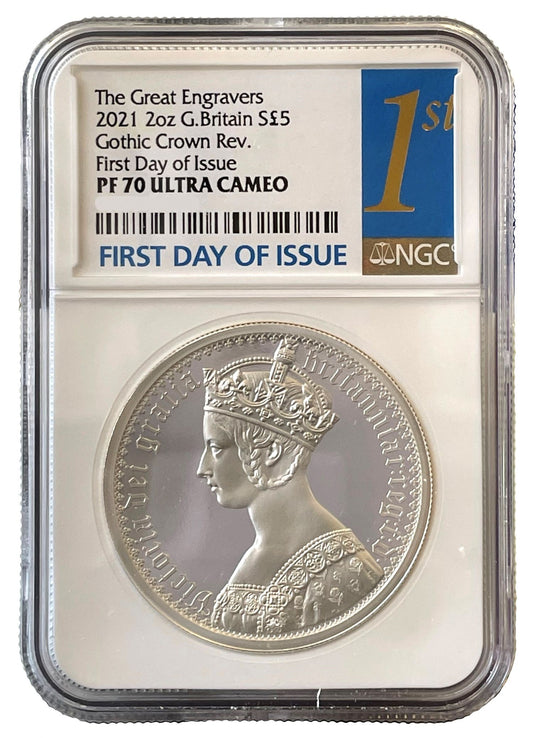FAQs
What makes a coin valuable?
I have coins to sell, what’s the next step?
How will my purchases be shipped?
What happens if I’m not entirely happy with my purchase?
Richard III Groat London, type 2b, mint mark Boars head 2 both sides
Richard III (1483-85), silver Groat, type 2b, London Mint facing crowned bust in double tressure of nine arcs, fleur de lis on cusps, beaded circles and Latin legend surrounding, initial mark boars head 2 both sides, RICARDx DIx GRAx REXxx AGLx Z FRAnC, rev. long cross pattée, tri-pellets in each inner angle, beaded circles and twin concentric legend surrounding, inner legend with barred A, CIVI TAS LOn DOn, outer legend surrounding, POSVI DEVmx A DIVTOR E' mEVm, weight 3.09g (N.1679; S.2156). Dark tone, a little uneven in shape, weak in parts of legend, with a great portrait, very fine.
The Latin abbreviated legend translates as "Richard, by the grace of God, King of England and France" and on the reverse "City of London" on inner circle and "I have made God my helper" in outer circle.
Richard III was born on the 2ndOctober 1452 at Fotheringhay castle to Richard the third Duke of York and his wife Cecily Neville. He was created Duke of Gloucester aged just nine on 28thJune 1461 after the accession of his elder brother Edward IV and went on to marry Anne Neville the widow of Edward Westminster the son of Henry VI in 1472. They had a son Edward of Middleham who pre-deceased them both still aged under ten on 9thApril 1484, and seen by some as some sort of divine retribution to leave Richard without a legitimate heir, after the manner in which he ascended the throne. The boy King Edward V, the nephew of Richard was dominated by his uncle as Lord Protector. Edward V was gone by the 25thJune 1483 never to be publicly seen again, and deposed by an act entitled Titulus Regius. Richard had kept postponing the coronation of Edward V after his arrival in London at the Tower on 19thMay 1483. In support of Richard, Ralph Shaa a theologian preached a sermon on 22ndJune 1483 that declared Edward IV had been already betrothed to Lady Eleanor Butler (1436-68) when he married Elizabeth Woodville rendering the marriage invalid and the children issued from it illegitimate. The children of Richard's older brother the Duke of Clarence were barred from the throne by their Fathers attainder who had been killed for high treason. Therefore, the path became clear for Richard who at an assembly of the Lords and Commons on the 25thJune 1483 was declared the legitimate King and he ascended the throne the next day. Edward V and his younger brother were taken to apartments in the inner Tower where at some point they disappeared presumed murdered. Richard was coronated on the 6thJuly 1483 upon which followed two major rebellions, an unsuccessful one in October 1483 led by Henry Stafford the second Duke of Buckingham leading to his beheading on the 2ndNovember, then what turned out to be a most successful one for Henry Tudor with his uncle Jasper, who in August 1485 landed in south Wales with French troops and marched through Pembrokeshire recruiting soldiers along the way, leading on to the Battle of Bosworth Field in Leicestershire on 22ndAugust 1485. Richard became the last English King to die in battle after leading a cavalry charge into the Tudor ranks in an attempt to kill Henry directly, but was unfortunately surrounded in marshy ground and struck down. The body was carried back to Leicester and after a period of display as some sources suggest, was interred at Grey Friars and a monument erected later for which Henry Tudor paid £50 and may have been visible as late as 1612 until the location was lost to history.
Fast forward to the 21stCentury and the modern-day Ricardian Society members working with archaeologists rediscovered the burial site in 2012 exhuming the skeleton, proving by DNA sequencing it was Richard III, and ending with a procession through the streets of Leicester with the remains on 22ndMarch 2015, for a reburial at Leicester Cathedral on the 26thMarch.
Capital City London upon the River Thames following Roman occupation, minted some of the earliest Saxon coins with gold Thrymsas and silver denarii with a "Londuniu" signature. Mercian Kings beginning with Offa minted coins there, but the first coin to actually say City of London upon it is the unique Ludica portrait Penny that was found in 2016, followed by subsequent coins of Ecgberht. In 871 the Danes wintered in London for the first time but was King Alfred of Wessex who settled and fortified the capital circa 880 to resist further invasions. Edward the Elder incorporated the City in Wessex in 911 and it resisted a major attack in the reign of Aethelred II in 1009. However, London submitted to the Danish Swein in 1013, but three years later the citizens accepted Eadmund Ironside as King and resisted a siege by Canute.
Later unsettled times occurred in the anarchy period of the reign of King Stephen, remaining loyal to the King except for a few months in 1141 when Empress Matilda was admitted but within a short time expelled. Coinage activity here has been mostly constant throughout history from the Romans until the reign of our current Queen and only moving out to Wales from 1969.
Provenance:
With an old pink Spink ticket in hands of May Sinclair and Patrick Finn purchased 12th November 1976.
Ex Spink Coin Auction, 6th July 2022, lot 140.
FAQs
What makes a coin valuable?
I have coins to sell, what’s the next step?
How will my purchases be shipped?
What happens if I’m not entirely happy with my purchase?













